A variety of tomatoes with a telling name - tomato “Neighbor's envy f1”: what is good and how to grow it correctly
The variety of vegetable varieties and hybrids often confuses any gardener. What to choose? Some prefer varietal crops, others prefer hybrid ones. When creating crossed crops, breeders try to take only the strongest qualities from varieties, so hybrids are more resistant to diseases and more resilient to weather conditions.
Tomato Neighbor's Envy f1 has not only the above advantages. This unique cluster hybrid has early ripening and excellent taste of ripe and juicy vegetables. Gardeners who know the tomato firsthand confidently advise every gardener to plant it in their beds.
Characteristics and description
The Neighbor's Envy tomato is an early-ripening cluster hybrid and is recommended for cultivation in greenhouse conditions. However, in the southern regions it is planted in open beds, where it takes root well without shelter.
Distinctive features
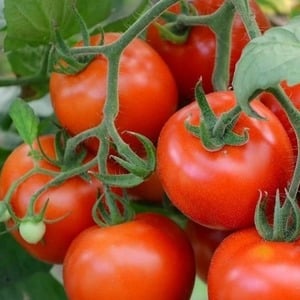
Type indeterminate, that is, without natural growth restrictions, requires mandatory garter to the support and stepsons.
Belongs to the carpal family, each brush bears up to 12 fruits.
The ripening period is early, from the moment of emergence of seedlings to full maturity, 85–95 days pass.
It is highly resistant to major tomato diseases and is practically not susceptible to late blight.
Productivity is high when placed on 1 sq.m beds of 3-4 seedlings harvest up to 17 kg of fruit.
Fruit characteristics
Average weight – 95–110 g, flat-round shape, bright red color. The pulp is juicy, the taste is sweet with noticeable sourness. Ripening occurs simultaneously, tomatoes do not crack from overripening and retain their presentation for a month.
Thanks to their dense peel, the fruits are universal in use, as they are not afraid of heat treatment. They are great for preserves, marinades and pickles. Ripe vegetables are also good in fresh salads, side dishes and hot dishes.
Tomatoes can withstand transportation over long distances without losing their appearance or taste.
The photo shows tomatoes Neighbor's Envy f1.
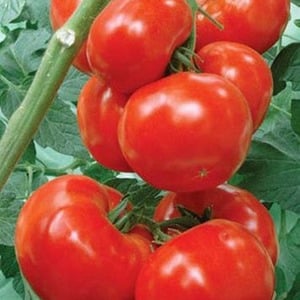
How to grow seedlings
Sowing seeds for seedlings is carried out on the 20th of March, having previously prepared the container, soil and seed.
Seed preparation
It is not possible to collect seeds from hybrid crops yourself, since they do not retain their parental properties. Purchased seed, as a rule, does not require disinfection, since disinfection is carried out by the manufacturer. But the seeds are soaked in a growth stimulant to improve germination.
Specialized drugs are used as stimulants, for example, Epin, Kornevin or Zircon. Folk remedies are no less effective: aloe juice, potato juice, melt water. As practice shows, the percentage of germination when using folk remedies and specialized preparations is the same. The seed material is soaked in the stimulator for 10–12 hours.
Reference. When seeds are placed in aloe juice, additional disinfection occurs, and potato juice enriches the grains with nutrients.
Container and soil
At the next stage, prepare the container and soil.The soil is made up of garden soil, peat, humus and river sand. Peat enriches the soil with useful substances necessary for the full development of seedlings, and sand acts as a leavening agent. After thoroughly mixing the components, the resulting soil mixture is spilled with a hot solution of dark-colored potassium permanganate. Disinfection is necessary to destroy pathogenic flora, which can have a detrimental effect on seedlings.
Before sowing, containers are also disinfected with a manganese solution. You can plant them in a common wooden box or in separate containers. Do not forget that when planting seeds in peat containers, picking and replanting the seedlings is not required in the future. Peat cups decompose in the ground on their own and feed the young roots with useful substances.
Reference. Peat cups are the most convenient, but most expensive way to grow seedlings.
At the bottom of the planting containers, small holes must be made that perform a drainage function. Without the drainage of excess moisture, the likelihood of developing blackleg, a dangerous disease during the seedling period, increases. It can destroy all plantings. Characterized by darkening and narrowing of the stem at the bottom.
Sowing
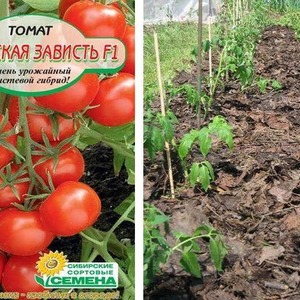
The seeds are planted in the grooves to a depth of 1.5–2 cm. If sowed superficially, they will germinate along with the seed coat, which will further slow down the growth of seedlings. After sowing, the soil is leveled and slightly compacted.
After moistening the soil with a spray bottle with warm, settled water, the planting containers are covered with film and left in a bright room at a temperature of 23 °C. Periodically, the film is removed to ventilate and moisten the top layer of soil as it dries out.
Growing and care
After the seedlings emerge, the containers are placed on the windowsill for sufficient lighting. With a daylight period of at least 13 hours, seedlings will grow stronger and faster than in the absence of the required amount of light.
As the top layer of soil dries out, the seedlings are moistened with warm, settled water from a shallow watering can. After watering, the soil is loosened superficially.
After 2 true leaves appear, the seedlings are planted in separate containers. During picking, weak plants are removed.
If growth is poor, 2 weeks after picking, the seedlings are fed with liquid fertilizer for tomato seedlings.
10 days before transplanting into the ground, the seedlings are hardened off so that they can quickly adapt to new conditions. Young bushes are left outdoors for 1 hour at first, increasing the time spent outside by 30–40 minutes every day. The night temperature in the room is reduced to 13 °C.
How to grow tomatoes
Seedlings are transplanted into the greenhouse at the end of April - beginning of May, into open ground - no earlier than mid-June. By this time, the bushes will have at least 6 true leaves and one flower cluster.
Landing
Planting pattern: 40 cm – distance between seedlings, 50 cm – between rows. For 1 sq. m place no more than 4 seedlings.
They are planted in pre-prepared holes 20 cm deep. Before transplanting, a little wood ash or sawdust is placed at the bottom of the holes and filled with warm water.
After planting, the holes are compacted, watered with warm water and left to adapt to new conditions for 10 days. During adaptation, young plants are not watered, since the roots do not absorb moisture.
Further care
After rooting, establish regular watering at least 2 times a week.On dry days, the amount of watering is increased, and on rainy days, on the contrary, it is reduced. The main indicator of the need for watering is the top layer of soil. Water only with warm water, as cold water can cause the root system to rot. To heat the water in barrels, expose it to the sun.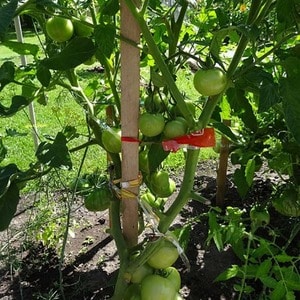
To retain moisture, the beds are mulched with straw. Mulch also performs a preventive function, protecting plantings from pests.
After watering, the soil is loosened and all weeds are removed. Weeds take from the soil many nutrients necessary for the development of tomatoes.
Seedlings are fed throughout the growing season once every 14 days. The necessary elements for full development are phosphorus, potassium and nitrogen. Nitrogen is introduced at the initial stage, as it stimulates the growth and expansion of green mass. Potassium is needed at the time of fruiting, and seedlings constantly need phosphorus. The full complex of minerals is alternated with organic matter - bird droppings or mullein infusion in a ratio of 1:15.
Features of cultivation and possible difficulties
To get maximum results, the bush is formed into 2 stems. All other stepsons are regularly removed to prevent the plantings from becoming dense. All lower leaves up to the first fruitful branch must also be removed.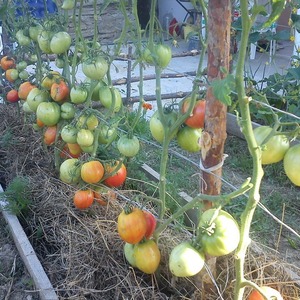
The pinching procedure is carried out early in the morning. The shoots that have reached 3 cm are removed, the cut areas are sprinkled with ash or treated with a manganese solution for disinfection. When removing shoots of more than 5 cm, pinching is painful for plants.
Tall seedlings need to be fixed to a support, otherwise the branches will not withstand the weight of the fruit.When transplanting into the ground, wooden stakes or metal rods are installed next to each plant, to which the stem and branches are fixed as they grow.
Also in greenhouse conditions tie up on the trellis. This is the most convenient garter option, as it is less traumatic for plants.
Diseases and pests
According to reviews, the Neighbor's Envy tomato is distinguished by its stable immunity to major diseases, so preventive measures are sufficient. When transplanting, young bushes are watered with a decoction of chamomile or nettle. Strong-smelling herbs prevent many flying and ground pests from approaching the beds, so marigolds, mustard bushes and calendula are planted in tomato beds.
Spraying with Fitosporin not only protects plants from fungal spores, but also increases their immunity.
Reference. "Fitosporin" is a systemic fungicide. It is used not only for prevention purposes, but also for the treatment of diseased plants.
Regular loosening and weeding prevent the proliferation of pests in tomato beds. Ventilation of protected structures performs the same function, destroying the usual habitat of greenhouse pests.
From insects The Colorado potato beetle and mole cricket are dangerous. The mole cricket moves underground, so it is difficult to notice. To scare it away, fish heads and chopped garlic cloves are dug into the beds. The Colorado potato beetle is collected by hand, carefully inspecting each seedling. When there is a large concentration of the pest, the drug “Prestige” is used.
Nuances for open ground and greenhouses
In outdoor conditions, the beds are chosen in a sunny, draft-free place. The soil is prepared in advance by digging and fertilizing with humus.
When planted in a staggered pattern, the plants receive enough sunlight without shading each other, and can be ventilated, which prevents fungal spores from developing.
The indeterminate type of plants implies unlimited growth. To ensure that nutrients are spent on the formation of fruits, and not on the growth of green mass, the crown of the plants is pinched, thereby determining the end point of growth.
The best option for moisturizing in greenhouse conditions is drip irrigation. With this method, moisture does not stagnate in the beds and does not increase the level of air humidity. Water constantly and gradually penetrates to the roots, and the plants do not suffer from lack of moisture.
Harvesting and application
The early ripening type of hybrid makes it possible to harvest at the beginning of the summer season. The fruits ripen at the same time, so they are collected in whole clusters. Tomatoes can be stored for a long time without losing their presentation and excellent taste.
The use of ripe vegetables is universal. They are consumed fresh marinate, canned and salted.
Advantages and disadvantages of a hybrid
Every culture has both advantages and disadvantages. Let's start with the positive aspects of tomato:
- early ripening;
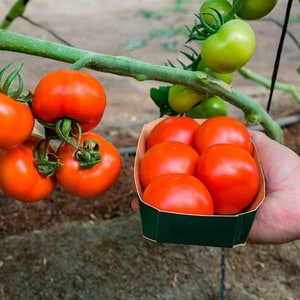
- high fruiting rate;
- easy to care for;
- possibility of breeding in all regions;
- formation of ovaries in any weather conditions;
- strong immunity to diseases;
- excellent taste of fruits;
- marketable condition;
- simultaneous maturation;
- long-term storage;
- possibility of long-term transportation.
The disadvantages include the need for formation, regular pinching and mandatory staking of seedlings.
Farmer reviews
Gardeners who have planted the Neighbor's Envy tomato in their beds confidently recommend it to other gardeners. Many experienced summer residents harvest twice during the summer, since the early ripening periods allow time to grow the second wave in the greenhouse.
Alexandra, Taganrog: “The Neighbor’s Envy grew the tomato in the same way as other similar crops: tied, pinched, fertilized. The result was excellent. The fruits are large, juicy, delicious, and simply lick your fingers. I made a lot of preparations and still have some left over for fresh dishes. In a word, all the neighbors are the envy of them.”
Svetlana, Krasnodar: “I planted it for the first time, but it’s already clear that the hybrid is extraordinary. There are at least 10 tomatoes on each cluster, and there are a lot of fruiting clusters on the seedling! All fruits are smooth, identical, beautiful. I go into the greenhouse, and my heart skips a beat with joy that I have such a miracle.”
Conclusion
Tomato Neighbor's envy f1 met the expectations of many gardeners. The hybrid is high-yielding, does not require careful care and does not get sick. The fruits do not crack due to overripeness. If you didn’t manage to harvest on time, don’t worry: tomatoes retain their appearance and taste for a month.
Unpretentious vegetables are in great demand in markets, which gives entrepreneurs an excellent opportunity to grow crops on an industrial scale.